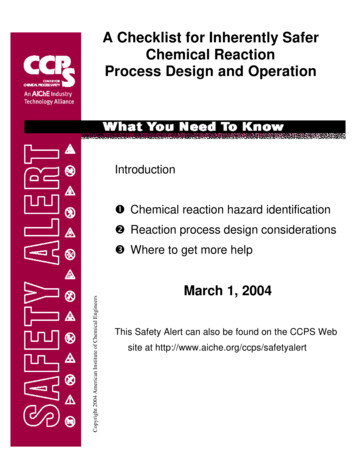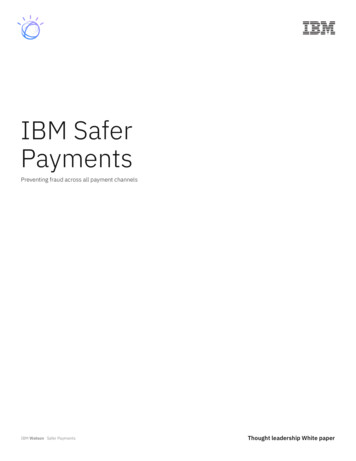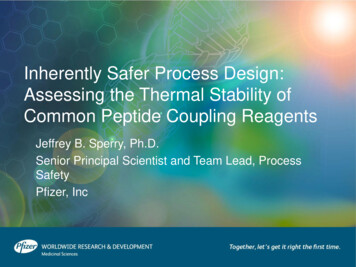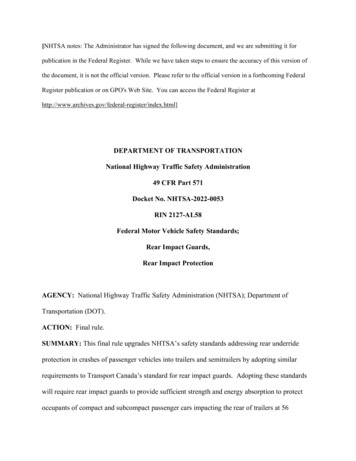
Transcription
A Checklist for Inherently SaferChemical ReactionProcess Design and OperationIntroductionŒ Chemical reaction hazard identification Reaction process design considerationsCopyright 2004 American Institute of Chemical EngineersŽ Where to get more helpMarch 1, 2004This Safety Alert can also be found on the CCPS Website at http://www.aiche.org/ccps/safetyalert
The Center for Chemical Process Safety was established by the American Institute of ChemicalEngineers in 1985 to focus on the engineering and management practices to prevent andmitigate major incidents involving the release of hazardous chemicals and hydrocarbons. CCPSis active worldwide through its comprehensive publishing program, annual technicalconference, research, and instructional material for undergraduate engineering education. Formore information about CCPS, please call 212-591-7319, e-mail ccps@aiche.org, or visitwww.aiche.org/ccpsCopyright 2004American Institute of Chemical Engineers3 Park AvenueNew York, New York 10016All rights reserved. No part of this publication may be reproduced, stored in a retrieval system,or transmitted in any form or by any means, electronic, mechanical, photocopying, recording, orotherwise without the prior permission of the copyright owner.It is sincerely hoped that the information presented in this document will lead to an even moreimpressive record for the entire industry; however, the American Institute of ChemicalEngineers, its consultants, CCPS Subcommittee members, their employers, and their employers’officers and directors disclaim making or giving any warranties, expressed or implied, includingwith respect to fitness, intended purpose, use or merchantability and/or correctness or accuracyof the content of the information presented in this document. As between (1) AmericanInstitute of Chemical Engineers, its consultants, CCPS Subcommittee members, theiremployers, and their employers’ officers and directors and (2) the user of this document, the useraccepts any legal liability or responsibility whatsoever for the consequence of its use or misuse.0CCPS Safety Alert, March 1, 2004
A Checklist for Inherently Safer Chemical ReactionProcess Design and OperationIntroductionReactive chemistry incidents continue to occur in the chemical processing industry,and other industries which handle chemicals in their manufacturing processes. Someexamples include: Lodi, New Jersey, 1995. An explosion during a blending operation resulted in fivefatalities and destruction of much of the manufacturing facility1 .Columbus, Ohio, 1997. An uncontrolled reaction in a phenol- formaldehyde resin plantkilled one worker, injured four others, and extensively damaged a plant 2 .Paterson, New Jersey, 1998. A runaway reaction in a batch dye manufacturing processinjured 9 people3 .Ringwood, Illinois, 2000. A decomposition reaction caused by water contaminationand a failed pressure controller on steam tracing resulted in a pipe rupture. Thisrelatively small incident resulted in no injuries or significant release of material, butdid bring about an awareness of potential reactive chemistry hazards and plantmodifications to prevent potentially more serious incidents in the future4 . This incidentalso illustrates that many years of incident-free operation does not mean that there isno reactive chemistry hazard – this plant operated for over 40 years without incidentuntil the wrong combination of events caused an unexpected chemical reaction whichruptured a pipe.These and other incidents have resulted in increased attention to reactive chemistryissues by industry, government, and other stakeholders. The United States ChemicalSafety and Hazard Investigation Board has completed a study of reactive chemistryaccidents in the United States, and identified 167 serious incidents between January 1980and June 20015 .Good process safety management systems, including consideration of reactivechemistry issues and the handling and storage of individual reactive chemicals, areimportant to operating a safe chemical process. This paper will focus on the technicalaspects of safety in chemical reaction manufacturing processes, rather than managementsystems. In general, process safety management systems for reactive chemistry hazardsare the same as for other chemical process hazards, and these are addressed in detail inmany other publications of the Center for Chemical Process Safety. However, theimplementation of process safety management systems for reactive chemistry hazardsdoes require some specific tools and practices, some of which will be discussed in thispaper. To help prevent future reactive chemistry incidents, we have summarized somebasic engineering principles for safe operation of chemical reaction processes.Consideration of these principles will aid in the development of inherently safer chemicalreaction processes.CCPS Safety Alert, March 1, 20041
Reactive chemistry hazards can result from any chemical reaction with the potential torelease heat, pressure, or toxic reaction products in quantities too high to be absorbed orcontained by the environment and equipment that holds the reacting mixture. It isimportant to distinguish between reactive chemicals and hazardous chemical reactions.The chemical substances in the process might no t be considered to be reactive chemicals,but this does not mean that the process does not have reactivity hazards. Interactions ofchemical substances may be more important for understanding process hazards than thereactivity of individual chemicals. Runaway reactions can occur from interactions amongchemicals not considered particularly reactive by themselves.The following checklist summarizes some important principles for design, scale up,and operation of chemical reaction processes. These principles are basic chemicalengineering, but it is valuable to summarize them in one place so they will be easy toremember.Chemical reaction hazard identification1. Know the heat of reaction for the intended and other potential chemical reactions.There are a number of techniques for measuring or estimating heat of reaction, includingvarious calorimeters, plant heat and energy balances for processes already in operation,analogy with similar chemistry (confirmed by a chemist who is familiar with thechemistry), literature resources, supplier contacts, and thermodynamic estimationtechniques. You should identify all potential reactions that could occur in the reactionmixture and understand the heat of reaction of these reactions.2. Calculate the maximum adiabatic temperature for the reaction mixture . Use themeasured or estimated heat of reaction, assume no heat removal, and that 100% of thereactants actually react. Compare this temperature to the boiling point of the reactionmixture. If the maximum adiabatic reaction temperature exceeds the reaction mixtureboiling point, the reaction is capable of generating pressure in a closed vessel and you willhave to evaluate safeguards to prevent uncontrolled reaction and consider the need foremergency pressure relief systems.3. Determine the stability of all individual components of the reaction mixture at themaximum adiabatic reaction temperature. This might be done through literaturesearching, supplier contacts, or experimentation. Note that this does not ensure thestability of the reaction mixture because it does not account for any reaction amongcomponents, or decomposition promoted by combinations of components. It will tell youif any of the individual components of the reaction mixture can decompose attemperatures which are theoretically attainable. If any components can decompose at themaximum adiabatic reaction temperature, you will have to understand the nature of thisdecomposition and evaluate the need for safeguards including emergency pressure reliefsystems.4. Understand the stability of the reaction mixture at the maximum adiabatic reactiontemperature . Are there any chemical reactions, other than the intended reaction, which2CCPS Safety Alert, March 1, 2004
can occur at the maximum adiabatic reaction temperature? Consider possibledecomposition reactions, particularly those which generate gaseous products. These are aparticular concern because a small mass of reacting condensed liquid can generate a verylarge volume of gas from the reaction products, resulting in rapid pressure generation in aclosed vessel. Again, if this is possible, you will have to understand how these reactionswill impact the need for safeguards, including emergency pressure relief systems.Understanding the stability of a mixture of components may require laboratory testing.5. Determine the heat addition and heat removal capabilities of the pilot plant orproduction reactor. Don’t forget to consider the reactor agitator as a source of energy –about 2550 Btu/hour/horsepower. Understand the impact of variation in conditions on heattransfer capability. Consider factors such as reactor fill level, agitation, fouling of internaland external heat transfer surfaces, variation in the temperature of heating and coolingmedia, variation in flow rate of heating and cooling fluids.6. Identify potential reaction contaminants. In particular, consider possible contaminantswhich are ubiquitous in a plant environment, such as air, water, rust, oil and grease. Thinkabout possible catalytic effects of trace metal ions such as sodium, calcium, and otherscommonly present in process water. These may also be left behind from cleaningoperations such as cleaning equipment with aqueous sodium hydroxide. Determine ifthese materials will catalyze any decomposition or other reactions, either at normalconditions or at the maximum adiabatic reaction temperature.7. Consider the impact of possible deviations from intended reactant charges andoperating conditions. For example, is a double charge of one of the reactants a possibledeviation, and, if so, what is the impact? This kind of deviation might affect the chemistrywhich occurs in the reactor – for example, the excess material charged may react with theproduct of the intended reaction or with a reaction solvent. The resulting unanticipatedchemical reactions could be energetic, generate gases, or produce unstable products.Consider the impact of loss of cooling, agitation, and temperature control, insufficientsolvent or fluidizing media, and reverse flow into feed piping or storage tanks.8. Identify all heat sources connected to the reaction vessel and determine theirmaximum temperature. Assume all control systems on the reactor heating systems fail tothe maximum temperature. If this temperature is higher than the maximum adiabaticreaction temperature, review the stability and reactivity information with respect to themaximum temperature to which the reactor contents could be heated by the vessel heatsources.9. Determine the minimum temperature to which the reactor cooling sources could coolthe reaction mixture. Consider potential hazards resulting from too much cooling, suchas freezing of reaction mixture components, fouling of heat transfer surfaces, increase inreaction mixture viscosity reducing mixing and heat transfer, precipitation of dissolvedsolids from the reaction mixture, and a reduced rate of reaction resulting in a hazardousaccumulation of unreacted material.10. Consider the impact of higher temperature gradients in plant scale equipmentcompared to a laboratory or pilot plant reactor. Agitation is almost certain to be lessCCPS Safety Alert, March 1, 20043
effective in a plant reactor, and the temperature of the reaction mixture near heat transfersurfaces may be higher (for systems being heated) or lower (for systems being cooled)than the bulk mixture temperature. For exothermic reactions, the temperature may also behigher near the point of introduction of reactants because of poor mixing and localizedreaction at the point of reactant contact. The location of the reactor temperature sensorrelative to the agitator, and to heating and cooling surfaces may impact its ability toprovide good information about the actual average reactor temperature. These problemswill be more severe for very viscous systems, or if the reaction mixture includes solidswhich can foul temperature measurement devices or heat transfer surfaces. Either a localhigh temperature or a local low temperature could cause a problem. A high temperature,for example, near a heating surface, could result in a different chemical reaction ordecomposition at the higher temperature. A low temperature near a cooling coil couldresult in slower reaction and a buildup of unreacted material, increasing the potentialchemical energy of reaction available in the reactor. If this material is subsequentlyreacted because of an increase in temperature or other change in reactor conditions, thereis a possibility of an uncontrolled reaction due to the unexpectedly high quantity ofunreacted material available.11. Understand the rate of all chemical reactions. It is not necessary to develop completekinetic models with rate constants and other details, but you should understand how fastreactants are consumed and generally how the rate of reaction increases with temperature.Thermal hazard calorimetry testing can provide useful kinetic data.12. Consider possible vapor phase reactions. These might include combustion reactions,other vapor phase reactions such as the reaction of organic vapors with a chlorineatmosphere, and vapor phase decomposition of materials such as ethylene oxide or organicperoxide.13. Understand the hazards of the products of both intended and unintended reactions.For example, does the intended reaction, or a possible unintended reaction, form viscousmaterials, solids, gases, corrosive products, highly toxic products, or materials which willswell or degrade gaskets, pipe linings, or other polymer components of a system? If youfind an unexpected material in reaction equipment, determine what it is and what impact itmight have on system hazards. For example, in an oxidation reactor, solids were known tobe present, but nobody knew what they were. It turned out that the solids were pyrophoric,and they caused a fire in the reactor.14. Consider doing a Chemical Interaction Matrix and/or a Che mistry Hazard Analysis.These techniques can be applied at any stage in the process life cycle, from early researchthrough an operating plant6 . They are intended to provide a systematic method to identifychemical interaction hazards and hazards resulting from deviations from intendedoperating conditions.4CCPS Safety Alert, March 1, 2004
Reaction process design considerations1. Rapid reactions are desirable. In general, you want chemical reactions to occurimmediately when the reactants come into contact. The reactants are immediatelyconsumed and the reaction energy quickly released, allowing you to control the reactionby controlling the contact of the reactants. However, you must be certain that the reactor iscapable of removing all of the heat and any gaseous products generated by the reaction.2. Avoid batch processes in which all of the potential chemical energy is present in thesystem at the start of the reaction step. If you operate this type of process, know theheat of reaction and be confident that the maximum adiabatic temperature and pressure arewithin the design capabilities of the reactor.3. Use gradual addition or “semi-batch” processes for exothermic reactions. Theinherently safer way to operate exothermic reaction process is to determine a temperatureat which the reaction occurs very rapidly. Operate the reaction at this temperature, andfeed at least one of the reactants gradually to limit the potential energy contained in thereactor. This type of gradual addition process is often called “semi-batch.” A physicallimit to the possible rate of addition of the limiting reactant is desirable – a meteringpump, flow limited by using a small feed line, or a restriction orifice, for example. Ideally,the limiting reactant should react immediately, or very quickly, when it is charged. Thereactant feed can be stopped if necessary if there is any kind of a failure (for example, lossof cooling, power failure, loss of agitation) and the reactor will contain little or nopotential chemical energy from unreacted material. Some way to confirm actual reactionof the limiting reagent is also desirable. A direct measurement is best, but indirectmethods such as monitoring of the demand for cooling from an exothermic batch reactorcan also be effective.4. Avoid using control of reaction mixture temperature as the only means for limitingthe reaction rate. If the reaction produces a large amount of heat, this control philosophyis unstable – an increase in temperature will result in faster reaction and even more heatbeing released, causing a further increase in temperature and more rapid heat release. Ifthere is a large amount of potential chemical energy from reactive materials, a runawayreaction results. This type of process is vulnerable to mechanical failure or operating error.A false indication of reactor temperature can lead to a higher than expected reactiontemperature and possible runaway because all of the potential chemical energy of reactionis available in the reactor. Many other single failures could lead to a similar consequence –a leaking valve on the heating system, operator error in controlling reactor temperature,failure of software or hardware in a computer control system.5. Account for the impact of vessel size on heat generation and heat removalcapabilities of a reactor. Remember that the heat generated by a reactive system willincrease more rapidly than the capability of the system to remove heat when the process isoperated in a larger vessel. Heat generation increases with the volume of the system – bythe cube of the linear dimension. Heat removal capability increases with the surface areaof the system, because heat is generally only removed through an external surface of thereactor. Heat removal capability increases with the square of the linear dimension. A largeCCPS Safety Alert, March 1, 20045
reactor is effectively adiabatic (zero heat removal) over the short time scale (a fewminutes) in which a runaway reaction can occur. Heat removal in a small laboratoryreactor is very efficient, even heat leakage to the surroundings can be significant. If thereaction temperature is easily controlled in the laboratory, this does not mean that thetemperature can be controlled in a plant scale reactor. You need to obtain the heat ofreaction data discussed previously to confirm that the plant reactor is capable ofmaintaining the desired temperature.6. Use multiple temperature sensors, in different locations in the reactor for rapidexothermic reactions . This is particularly important if the reaction mixture containssolids, is very viscous, or if the reactor has coils or other internal elements which mightinhibit good mixing.7. Avoid feeding a material to a reactor at a higher temperature than the boiling pointof the reactor contents. This can cause rapid boiling of the reactor contents and vaporgeneration.Resources and PublicationsThere are many valuable books and other resources to help in understanding andmanaging reactive chemistry hazards. Some particularly useful resources include: American Institute of Chemical Engineers, Center for Che mical Process Safety, SafetyAlert: Reactive Material Hazards, New York, 2001.Bretherick’s Handbook of Reactive Chemical Hazards, Butterworth-Heineman, 1999.Chemical Reactivity Worksheet, U. S. National Oceanic and AtmosphericAdministration, t.htmlAmerican Institute of Chemical Engineers, Center for Chemical Process Safety,Guidelines for Safe Storage and Handling of Reactive Materials, 1995.American Institute of Chemical Engineers, Center for Chemical Process Safety,Guidelines for Chemical Reactivity Evaluation and Application to Process Design,1995.United Kingdom Health and Safety Executive, Designing and Operating SafeChemical Reaction Processes, 2000.Barton, J., and R. Rogers, Chemical Reaction Hazards: A Guide to Safety, GulfPublishing Company, 1997.Johnson, R. W., S. W. Rudy, and S. D. Unwin. Essential Practices for ManagingChemical Reactivity Hazards. New York: American Institute of Chemical Engineers,Center for Chemical Process Safety, 2003.SummaryWe hope that the use of this checklist will help in developing, designing, scaling up,and operating inherently safer chemical reaction processes. This checklist includes manysuggestions which have proven valuable in designing reactive chemistry processes over6CCPS Safety Alert, March 1, 2004
the years. Like any checklist, it cannot cover all possible situations and circumstances, andit will be incomplete. We welcome suggestions to improve this checklist from readersbased on their own background and experience. If you have suggestions for improvement,please e- mail them to ccps@aiche.org, and please let us know whether your suggestionmay be included in future editions of this publication.AcknowledgementsThis Safety Alert was updated from a paper by Dennis Hendershot, Senior TechnicalFellow at Rohm and Haas Company, which was presented at the 17th Annual CCPSInternational Conference and Workshop in Jacksonville, FL, October 2002.Any checklist or guidance document is a compilation of the knowledge and experienceof the people who provided input into creating it. Drafts of this document were reviewedby a number of people who provided valuable contributions and clarifications. Thanks toGary Carrithers, John Chin, Art Dowell, Dallas Green, Greg Keeports, Al Ness, FrankRenshaw, Paul Snyder, and Cheryl Teich from Rohm and Haas Company, Rohm and Haasretirees and active consultants Don Koestler and Sam West, and John Murphy of theUnited States Chemical Safety and Hazard Investigation Board.Last, but certainly not least, a sincere thanks and to Rohm and Haas Company forsupporting CCPS and other important safety organizations and for allowing this materialto be re-published in this form.References1.EPA/OSHA Joint Chemical Accident Investigation Report: Napp Technologies, Inc., Lodi, New Jersey.Washington, D. C.: United States Environmental Protection Agency and United States Occupational Safetyand Health Administration, October 1997, Report No. EPA 550-R-97-002.2.Chemical Safety Case Study: How to Prevent Runaway Reactions. Washington, D. C., United StatesEnvironmental Protection Agency, Chemical Emergency Preparedness and Prevention Office, August 1999,Report No. EPA 550-F99-004.3.Investigation Report: Chemical Manufacturing Incident. Washington, D. C.: United States Chemical Safetyand Hazard Investigation Board, August 2000, Report No. 1998-06-I-NJ.4.Hendershot, D. C., A. G. Keiter, J. Kacmar, J. W. Magee, P. C. Morton, and W. Duncan. “Connections:How a Pipe Failure Resulted in Resizing Vessel Emergency Relief Systems.” Proceedings of the 36thAnnual Loss Prevention Symposium, March 10-13, 2002, New Orleans, LA, ed. H. L. Febo and J. F.Murphy, Paper LPS-6c. New York: American Institute of Chemical Engineers.5.Improving Reactive Hazard Management. Washington, D. C.: United States Chemical Safety and HazardInvestigation Board. October 2002 (Report No. 2001-01-H).6.Mosley, D. W., A. I. Ness, and D. C. Hendershot, “Screen Reactive Chemical Hazards Early in ProcessDevelopment.” Chemical Engineering Progress 96, 11 (November), pp. 51-63, 2000.CCPS Safety Alert, March 1, 20047
Sponsors of the Center for Chemical Process Safety3M CompanyABB Lummus GlobalAbbott LaboratoriesABS Group Inc.AcuTech ConsultingAir Products & Chemicals, Inc.AIU Energy/Starr Technical RisksAKZO Nobel Chemicals, Inc.Arch ChemicalsATOFINA Chemicals, Inc.BASF CorporationBaker Engineering & Risk ConsultantsBayer CorporationBuckman LaboratoriesBPBristol-Myers Squibb CompanyCelanese ChemicalsChevronTexacoCiba Specialty Chemicals CompanyConocoPhillipsContra Cost County Health ServicesCYTEC IndustriesDegussa CorporationDNVThe Dow Chemical CompanyDuPont CompanyEastman Chemical CompanyEastman Kodak CompanyEli Lilly and CompanyExxonMobilFluor EnterprisesFM Global8FMC CorporationFormosa Plastics Corporation (USA)GE PlasticsGeorgia PacificHoneywell, Inc.International Specialty Products, Inc.IoMosaicJohnson and JohnsonJohnson PolymerKBRThe Lubrizol CorporationLyondell Chemical CompanyMarsulex Inc.Monsanto CompanyNOVA Chemicals Ltd.Occidental Chemical CorporationOlin CorporationPfizer, Inc.PPG Industries, Inc.Primatech, Inc.Reilly Industries, Inc.Rhodia, Inc.Risk Reliability and Safety EngineeringRohm and Haas CompanyShell Chemical CompanySolutia Inc.Syncrude Canada Ltd.Syngenta Crop ProtectionTNO Initiative for Industry SafetyUS Chemical Safety and Hazard Investigation BoardUS EPA/OEPPRWestinghouse Savannah River CompanyCCPS Safety Alert, March 1, 2004
Safety and Hazard Investigation Board has completed a study of reactive chemistry accidents in the United States, and identified 167 serious incidents between January 1980 and June 20015. Good process safety management systems, including consideration of reactive chemistry issues and the handling and storage of individual reactive chemicals, are











